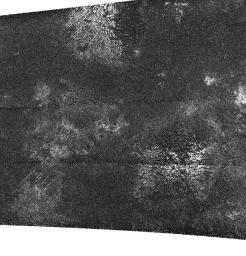In this synthetic aperture radar image obtained by NASA's Cassini spacecraft, two generally similar features, upper center and lower right, appear to be low mountains with grooves running roughly in the up-down direction. A set of straight lines are also visible at lower left. But what made the grooves? Grooves can result from forces that originate from within a planet, including forces that pull the crust of a planet apart and cracks produced by melt intruding into the crust. They can come from external forces like wind or rainfall, which produces river channels that can cut down through layers of rock. All of these produce grooves on Earth's surface, and may also be at work on Titan.
Another intriguing thing about this image is that in this image the "light" (actually the radar illumination) comes from the top. With this kind of illumination, the upper side of these mountains should be bright because they face the illumination, but the left side of the upper-center feature and the right side of the lower feature are bright. The brightness indicates that there is a different material in these areas, and the grooves exist in both dark and light materials.
The Titan Radar Mapper acquired this image at 41 degrees north latitude and 213 degrees west longitude on December 28, 2009. The image measures 250 kilometers (160 miles) high and 285 kilometers (180 miles) wide, with resolution of about 350 meters (1,100 feet) per pixel. North is left, and the image is illuminated from the top. Incidence angle varies from 11 to 25 degrees.
Two dark horizontal lines that run across the middle of the image show the joints between individual radar beams and are not features on the Titan surface.
The Cassini-Huygens mission is a cooperative project of NASA, the European Space Agency and the Italian Space Agency. NASA's Jet Propulsion Laboratory, a division of the California Institute of Technology in Pasadena, manages the mission for NASA's Science Mission Directorate, Washington, D.C. The Cassini orbiter was designed, developed and assembled at JPL. The radar instrument was built by JPL and the Italian Space Agency, working with team members from the United States and several European countries.
For more information about the Cassini-Huygens mission, visit http://saturn.jpl.nasa.gov/ and http://www.nasa.gov/cassini.

 Planetary Data System
Planetary Data System












